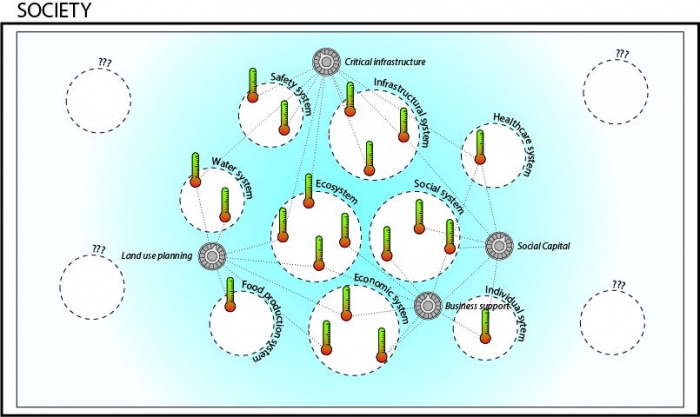Eigenschappen
| Context | Ecologie en duurzaamheid |
|---|---|
| prefLabel | Resilience@en |
| altLabel | |
| hiddenLabel | |
| inScheme | Waterveiligheid |
| subject | |
| broader | |
| narrower | |
| partOf | |
| association | |
| related | |
| creator |
De View-Navigation (VN) pagina's.
In this research society is considered as the main system. Society is a socio-cultural system and involves human actions, meaning we are dealing with a soft system (Checkland). A system is a set of interacting or interdependent entities forming an integrated whole. A system consists of a set of entities and a set or relations.
To explore the society as a system in relation to community resilience in delta areas, the metaphor of map is applied in this research. Literature about (community) resilience, disasters and crises, delta management and several other themes, are used as point of direction and heading for a multidisciplinary expedition. Complex systems theory is used to provide a common language among the disciplines. During the expedition this language will also be incorporated and proceeded into a thesaurus about community resilience in delta areas.
As a first step the areas of interest for the expedition are indicated on a map. In terms of research these areas are specified as subsystems. It is possible to define subsystems within social research, but it is not possible to apply a reductionist approach to human systems, since human behavior is different in each situation (Checkland). A subsystem is a subset of entities and their interactions which is part of a larger system. Boundaries between subsystems depend on a strong internal cohesion among entities within the system and a low coupling with other entities in relation to the function of the specific subsystem. A subsystem is a system in itself, but on a lower level of aggregation. In the research programme Resilient Deltas the following subsystems of society are distinguished in relation to community resilience:
The selection of these subsystems are based on previous research, practical knowledge and the application and adaptation of literature on community resilience to delta areas in particular. This results for example in the inclusion of the water system.
Besides subsystems, also aspect systems can be defined. In aspect systems, the boundaries of the larger system remain unchanged. Aspect systems zoom in on a specific part of the considered relations between the entities. Finances are an example of an aspect system.
An indicator is defined as bits of information that summarize the characteristics of a system or highlight what is happening in a system. They help us to understand where we are, where we are going and a pointer to something that is changing. Indicators are presentations of measurements.
In the next figure system indicators are coupled to each subsystem. In our research these indicators are considered as ‘internal system indicators’. Internal systems indicators are a qualitative representation of the subsystems, which have a direct or effect on the livability of communities.
In last session we have assumed some relations between internal system indicators within each subsystem. Following preliminary indicators were provided (draft list to give some idea):
Social system
- Well-being
- Education
- Housing
- Care
- ...
Economic system
- Economic resources
- Employment
- ...
Ecosystem
- Healthy living environment
- Biodiversity
- Raw Materials
- ...
Water system
- Water Quality
- Water Control (quantity)
Infrastructural system
- Mobility
- Energy
Food supply
- Food
One of the main challenge is to clarify and validate the relations of the internal system indicators with the livability of communities /well-being of society. The assumed relations are not represented in the figures in this document.
External system indicators are measurements of more general statistical data, like demographics. Each external system indicator may have multiple relations with internal system indicators. One of the main challenges of the research is to find the relations between the internal and external system indicators. Considering the subsystems and their relations a limited set of key activities can be distinguished that are relevant to enhance the resilience of communities in delta areas. In this research these key activities are defined as levers. For a definition of Levers and use in Resilience see: Rand, 2011 -> see also concept paper about the Windmill model (cascade effects). The distinguished levers correspond with the key community subsystems in resilience literature (Longstaff et al., 2010). "In order to help communities think about their resilience, our approach employs the concepts described above to assess each one of five key community subsystems: ecological, economic, civil society, governance, and physical infrastructure. These five were chosen based on an exhaustive review of academic and policy oriented literature, and lengthy discussions on a set of sub-systems that, together, captured the core functions within a community." (Longstaff et al., 2010) Levers differ from subsystems , since levers are activities that can take place within specific subsystems. However they might to a certain degree resemble with each other. Four of the identified levers in this research are related to specific content-based subsystems. Governance is a more process oriented subsystem, focusing on facilitating and controlling transformations in the other subsystems. The 4+1 levers in this research are following:
- Economic drivers
- Social capital
- Critical infrastructure
- Land-use and water management
plus
- Governance
Insights from the expedition and the map will be used to gain more insight in resilience as a process and make it useful for practitioners in the Southwestern Delta. Resilience as a process: Exposure / Vulnerability / Adaptabaility (to elaborate…)








